RFID (Radio Frequency Identification) and QR codes (Quick Response Code) are widely used technologies in warehouse management and other fields. However, they differ in how they function and are applied. This article compares RFID and QR code technologies, helping you choose the best solution for your business.

Overview of RFID and QR Code
Definition
-
RFID: RFID is a technology that identifies objects using radio frequency waves. This system can detect multiple objects simultaneously through radio signal transmission, allowing data to be sent and received between an RFID tag and a reader over a distance without direct contact.
-
QR Code: QR code is a two-dimensional barcode (2D) that consists of black and white squares and dots, capable of encoding data both horizontally and vertically. QR codes can be scanned by specialized readers or directly through a smartphone camera with a dedicated QR code scanning application.
How They Work
-
RFID: In an RFID system, the reader is fixed at a location, transmitting radio waves at a specific frequency to detect nearby RFID tags. When an RFID tag enters this range, it receives energy from the radio waves and sends its information back to the reader. This allows RFID to detect and communicate with multiple objects without requiring direct visual contact.
-
QR Code: With its square design, QR codes are equipped with markers in three of the four corners, which help the scanner recognize the code's boundaries. This enables fast and accurate data reading from various angles, eliminating the need to adjust the camera continuously, as with traditional barcodes.
Applications
Both RFID and QR codes have similar functions such as online payments and product traceability. However, RFID has broader applications in warehouse management, smart vehicle integration, contactless smart cards, and tracking livestock on farms.
On the other hand, QR codes are often used to create links, directing users to specific websites or digital content. QR codes are also more accessible for small businesses due to their low cost and the widespread use of smartphones.
Detailed Comparison

Conclusion
Choosing between RFID and QR code depends on the specific needs of your business. RFID is suitable for more complex systems requiring tracking of multiple items over long distances, such as large warehouse management or production line control. In contrast, QR code is ideal for simpler applications, particularly for small businesses where quick and easy data retrieval is essential.
In summary, both technologies have their strengths and weaknesses. Businesses should carefully evaluate their specific needs to make the most suitable choice.
Source: Do Van Dat - TEBS Department